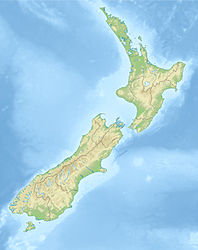Marlborough earthquake of 1848
| Marlborough earthquake of 1848 | ||
|---|---|---|
|
|
||
| Coordinates | 41 ° 48 ′ 0 ″ S , 173 ° 42 ′ 0 ″ E | |
| date | October 16, 1848 | |
| Time | 02:10 | |
| intensity | 10 on the MM scale | |
| Magnitude | 7.7 M W | |
| depth | 20 km | |
| epicenter | Awatere Fault | |
| country | New Zealand | |
| Affected places | ||
| Tsunami | No | |
| dead | 3 | |
The Marlborough earthquake of 1848 was the first earthquake to cause severe damage in the newly established town of Wellington in the New Zealand colony and to have lasting effects on its residents.
The first European settlers arrived at Port Nicholson , the former port of Wellington, in 1840. Recruited by the New Zealand Company , they did not know what to expect. After their arrival, the settlers made the acquaintance of numerous smaller earthquakes in the region, but carefree they built their city on the European model, with buildings made of bricks and rubble . Cheaper buildings were made of wood. The city was ill-prepared for October 16, 1848.
geography
The quake had its center in the Awatere Fault , which follows a valley northwest of the Inland Kaikoura Range in the Marlborough region , in which the Awatere River flows in a north-easterly direction into the Pacific Ocean . The fault has a length of about 105 km on the land side, starting from Clifford Bay , and ends before the Alpine Fault .
The quake
On October 16, 1848 at around 2:10 a.m. (other sources assume 1:40 p.m.), during a severe storm with lots of rain, the first shock wave came unexpectedly and shook the earth for about two minutes, followed by strong vibrations in the next ten minutes. The quake was felt from Hawke's Bay all the way down into the Canterbury region . Depending on the source, the magnitude of the earthquake to 7.1 M W , of 7.4 M W to 7.7 M W , M, or 7.5 W amounted.
The judge and later politician and journalist Henry Samuel Chapman noted 100 aftershocks between 1:40 and 6:00 a.m. in his notes. Lighter vibrations with shock waves occurring every minute are said to have been observed for over an hour.
At the time of the earthquake, the Marlborough region was still sparsely populated; Wellington and Nelson were the first two major settlements. That is why the quake particularly affected these two cities. Many Māori settlements were along the eastern coast, but were not as badly affected by damage due to the less fragile construction of their houses.
In Wellington, many brick or stone houses were damaged in the first shock wave. The wooden houses held up, but not their chimneys. Severe aftershocks on October 17 and October 19 also caused the damaged houses to collapse. The three people who died in the quake died on October 17th when a wall collapsed.
The as 1848-1853 Lieutenant-Governor for the province of New Munster used Edward John Eyre described Wellington then as " city in ruins ", " terror and horror reign everywhere ", " ships in harbor, filled with colonialists who want to leave the country ". He received public criticism from the local press for " spreading desolation and gloom ". Also, it was not in the New Zealand Company's interests to spread the word about the earthquake as it thwarted their business with the Wellington settlements. At the instigation of the New Zealand Company , the quake was little known, mostly in England .
Many people slept on the ships in Port Nicholson harbor for fear of further tremors. When the Bark Subraon with 60 settlers on October 26, Wellington towards Sydney wanted to leave the ship struck rocks and capsized. All passengers were rescued and many of them eventually stayed in Wellington for reconstruction.
After the clean-up, the residents of Wellington began to build their houses using wood, with wise foresight, as the Wairarapa earthquake of 1855 would show only seven years later.
See also
literature
- Nicola McCloy : New Zealand Disasters . Whitcoulls Ltd. , Auckland 2004, ISBN 1-877327-34-4 (English).
- Rebecca Ansell, John Taber : Caught in the Crunch - Earthquakes and Volcanoes in New Zealand . Harper Collins Publishers (NZ) Ltd. , Auckland 1996, ISBN 1-86950-201-9 (English).
Web links
- The 1848 Marlborough earthquake . Te Ara - The Encyclopedia of New Zealand,accessed March 1, 2010.
Individual evidence
- ↑ a b M 7.4 - 7.7, Marlborough, October 16, 1848 . GeoNet - GNS Science , accessed on April 5, 2013 (English).
- ↑ a b c The 1848 Marlborough earthquake . Te Ara - The Encyclopedia of New Zealand , accessed March 1, 2010 .
- ^ Ansell, Taber : Caught in the Crunch . 1996, p. 84 .
- ^ Ansell, Taber : Caught in the Crunch . 1996, p. 80 .
